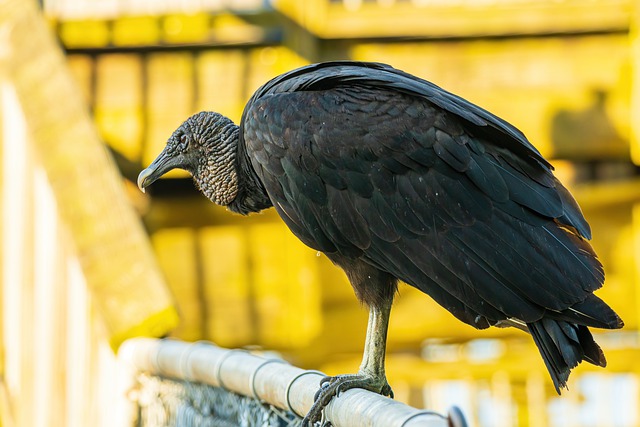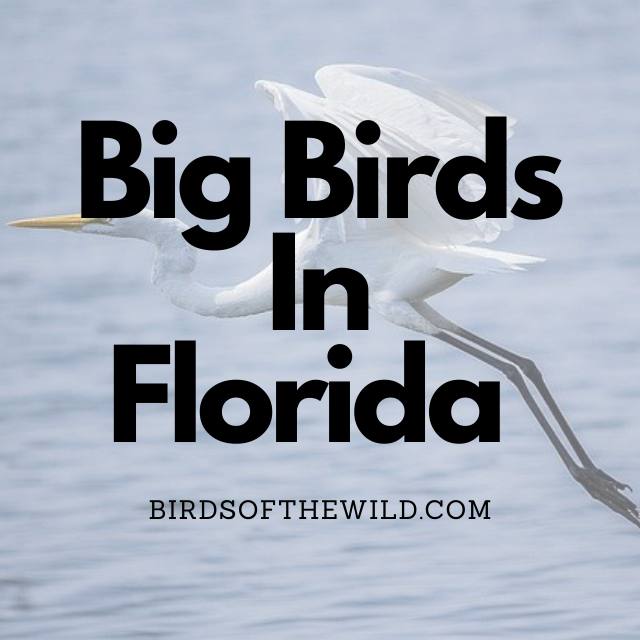Florida is home to a variety of large animals from alligators to wild boars and of course, as I’ll be discussing in the article, very large birds. In this article I’ll be going over 7 unique big birds that can be found in Florida to look out for if ever you go out to look for some.
- Wood Stork
- American White Pelican
- Great Egret
- Sandhill Crane
- Snowy Egret
- American White Ibis
- Black Vulture
7 Big Birds In Florida
1. Wood Stork (Mycteria Americana)

- Size: 83 – 120cm
- Weight: 2.3 – 2.6kg
- Wingspan: 140 – 165cm
You can spot wood storks in southern and central Florida year round, whilst in the northern they tend to only stay their throughout winter and the eastern area is for when they happen to breed.
Wood storks are recognised by their mostly white plumage, black legs, their black featherless head and a large pointy beak. The only difference between male and female wood storks would be that females are slightly smaller than the males.
You’ll often spot wood storks around fresh and brackish forested wetlands, where they will often forage around wetlands, swamps, ponds, and marshes with water depths of around 10 – 30cm.
As for what they eat, it includes fish, frogs, crayfish, large insects, and occasionally small alligators and mice.
Wood storks are known to live for 11 – 18 years in the wild, whilst the oldest known captive stork hit 27 years and 6 days.
2. American White Pelican (Pelecanus Erythrorhynchos)

- Size: 130 – 160cm
- Weight: 6 – 6.5kg
- Wingspan: 260 – 290cm
American white pelicans can be found in Florida throughout their non breeding months, which would normally be throughout late fall and winter.
These pelicans can be recognised by their mostly white plumage and extremly large bills. Females look vey similar to the males.
You’ll often spot these birds aroud lakes and rivers.
As for what they eat, it includes moslty fish of the rough kind that humans don’t typically capture, smaller amphibians and crayfish.
Wild American white pelicans are known to live for around 16 years whilst captive can hit around the 30 – 35 year range.
3. Great Egret (Ardea Alba)

- Size: 80 -100cm
- Weight: 0.7 – 1.5kg
- Wingspan: 130 – 170cm
These egrets can be found in Florida year round as it’s one of their permanent residences within the country.
Great egrets are recognised by their extremly long necks, yellow bill, long black legs and mostly white plumage. Both males and females look very similar with the males being generally larger than the females.
Great egrets spend the majority of their time within marshes, ponds, shores and mud flats.
As for what they eat, it includes primarily fish along with crustaceans, amphibians, and small mammals. They will also forage around open areas.
Great egrets tend to live for around 15 years in the wild and around 22 years in captivity
4. Sandhill Crane (Grus Canadensis)

- Size: 91 – 151cm
- Weight: 2.72 – 6.34kg
- Wingspan: 150 – 190cm
Sandhill cranes came be found in the southern and central regions of the state year round whilst further north, these cranes only seem to stay when they aren’t breeding.
Sandhill cranes whether the lesser or greater variant are recognised by their gray and brown plumage, their long neck and legs as well as the red spot on their face. They also have a jet black beak. Males are generally bigger than the females whilst the females don’t have any red spots near the eyes and beak.
These cranes tend to spend the majority of their time at open habitats within small bogs, marshes, and prairies. They will also build nests within the same areas they inhabit, but ideally would want the area to be isolated.
Sandhill cranes eat mostly seeds, grains, insects and small animals like worms, mice, small birds, snakes, lizards, frogs and crayfish.
These cranes have a lifespan that extends upto 20 years in the wild.
5. Snowy Egret (Egretta Thula)

- Size: 56 – 66cm
- Weight: 350 – 390 grams
- Wingspan: 95 – 105cm
You can spot snowy egrets in Florida year round as it’s a place where they seem to permanently spend their time.
Snowy egrets as their name would suggest are snow white birds with a long neck, black beak, black legs whilst also having a relatively large frame. Besides their sexual organs the only differentiating factors between males and females are that the males are slightly larger.
You’ll find these egrets by mudflats, beaches, and wetlands, but you can also see them forage in wet agricultural fields and along the edges of rivers and lakes.
Snowy egrets eat a variety of foods from fish, insects, crustaceans which includes crabs, crayfish, frogs, snakes, snails, worms, lizards, rodents and more.
These egrets are known to live for around 5 – 6 years in the wild and upwards of 16 years in captivity.
6. American White Ibis (Eudocimus Albums)

- Size – 53 – 70cm
- Weight – 920 – 970 grams
- Wingspan – 90 – 105cm
You cans spot American white ibis in Florida year round as it’s a permanent residence of theirs in the states.
The American white ibis is recognised by its white plumage, long neck, long and pointy beak as well as by its pink legs. Females look more or less the same but a little smaller whilst also having a smaller beak. As for how big their beak can get, it will normally reach around 15 – 20cm mark.
White ibis can be seen around coastal marshes and wetlands where you will often find them feeding in fresh, brackish, and saltwater environments.
As for what they eat it includes aquatic animals such as fish, snails and crayfish. Furthermore, in recent times they’ve even gotten accustomed to eating bread, fast food or pop corn.
These long billed birds are known to live between 16 – 27 years.
7. Black Vulture (Coragyps Atratus)

- Size: 56 – 74cm
- Weight: 1.2 – 1.9kg
- Wingspan: 1.3 – 1.7m
You can spot black vultures throughout Florida year round as it one of their many permanent residencies within the states.
Black vultures are recognised by their almost entirely black body with elements of gray on their head and feet. The male and female vulture are not sexually dimorphic so its isn’t easy to tell them apart.
You can find black vultures living year round in forested and open areas, where most tend to spend their time in lower elevations.
Vultures are scavengers by nature and it’s no different here where their primary food source is carrion. They prefer feeding on fresh carcasses but, they are able to consume the same carcass over several days. On occasion black vultures will hunt live prey although live prey, whether mammals or birds, are weakened or sick making it an easier catch for them.
In regards to lifespan, wild black vultures tend to live for around 10 years whilst captive one are capable of living for 30 years.
Amhil Khan, a dedicated nature enthusiast and the founder of BirdsOfTheWild.com, is a passionate advocate for the captivating world of avian wonders. With a deep-seated curiosity about the intricate lives of birds, Amhil’s journey began as a fascination and has evolved into a mission to inspire others to appreciate and protect these magnificent creatures.
Amhil’s love for birds led to the creation of Birds of the Wild, a platform where his expertise in ornithology, coupled with his captivating storytelling, provides readers with an immersive and educational experience. Through his lens and words, he captures the essence of birds in their natural habitats, offering a glimpse into their behaviors, migrations, and the ecosystems they inhabit.

